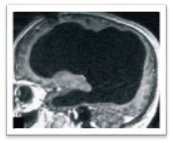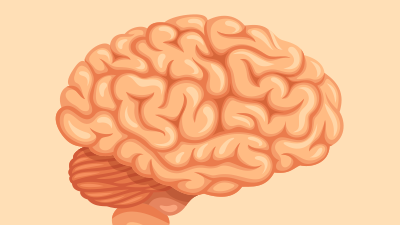
How Much Brain Do We Need to Be Human?
The design and plasticity of the human brain shows God’s goodness.
If the human brain were so simple
That we could understand it,
We would be so simple
That we couldn’t.
— Emerson M. Pugh
The human brain is an amazing organ, but its function has not always been well understood or appreciated. Ancient Egyptians believed it to be the equivalent of packing material, something like organic bubble wrap. In the process of mummification, other organs were carefully excised, preserved, and stored in special jars while the brain was extracted through the nose and tossed! Aristotle thought that the brain provided a cooling mechanism for the blood, functioning as a radiator for the all-important heart. Other early physiologists claimed the brain was merely an outgrowth of the spinal cord, revealing similar underestimation of the many varied complex functions of the human brain.
Since that time, there has been rigorous research conducted in the realms of neuroanatomy and neurophysiology. A wealth of new information has been gathered and the more we explore, the more we discover! Like peeling an onion, teasing back one layer only reveals yet another. And so, over the centuries, mankind has been working to peel the onion, layer by layer. Peeling past the convoluted, external surface (that certainly looked suitable for cushioning or cooling), we have learned there are well-defined anatomical regions, each apparently serving specific functions. And there are sophisticated cellular processes that carry out the nearly instantaneous relay of information throughout the body. But there are also elusive, intangible aspects that continue to evade our understanding—and some clinical observations that make us question everything we thought we knew!
Delegation of Tasks, Relegation to Regions
Closely examining the brain’s anatomical layers, we have identified unique and identifiable regions within the brain. It is far more than packing material! We now understand that the cerebrum, comprised of left and right hemispheres, performs higher functions, such as speech, judgment, thinking and reasoning, problem-solving, emotions, and learning—as well as processing sensory-related inputs involved in vision, hearing, and the other senses. The cerebellum coordinates muscle movements and maintains posture and balance. The brainstem connects the cerebrum and cerebellum to the spinal cord and regulates basal functions such as breathing, heart rate, body temperature, sleep cycles, digestion, and respiratory functions.
Clever experiments have allowed us to map which parts of the brain are responsible for specific tasks. Interestingly, it appears that the right brain controls the left side of the body and vice versa, with signals from one side of the body crossing over to the opposite side of the brain through the centrally located corpus callosum. We have discovered that the occipital lobe is involved with vision; and the auditory cortices process sound and enable hearing. The motor cortex in the frontal lobe allows for the precise voluntary movements of our skeletal muscle, while the Broca area is a region that instructs the motor cortex specifically in speech production. The list could go on and on, with various areas associated with specific functions. The observation that injury to those areas impairs those very functions would appear to validate the inferred associations.
Conceivable Mechanisms Put to Inconceivable Uses
We have made many amazing advances at the cellular level of brain function as well.
We have made many amazing advances at the cellular level of brain function as well. The discovery of neurons and the role of chemical signaling in neurotransmission has further advanced our knowledge of how the nervous system relays information throughout the body. Support structures such as myelination of the axon with intentional gaps at the node of Ranvier explain how the electrical impulse can be transmitted so quickly down the axon. Glial cells have been found to provide physical and chemical support to neurons, acting as a sort of glue to maintain and support them.
But what about some of the more abstract functions? The concept of memory offers yet another glimpse into the amazing complexity of the human brain. Rather than being able to pinpoint a specific region of the brain that is responsible for memories, there is a cascade of events that happens involving multiple regions of the brain. A specific memory may form in the hippocampus and be held for short-term storage but then later be transferred to the neocortex for long-term storage. Furthermore, the amygdala can attach emotional significance to the memory. Memories that evoke joy or comfort—or, maybe especially, anxiety or fear—can help guide decision-making in the future and increase our chance of survival. Yet, how does a thought even form? How is it encoded in our brain in a format that we can recall? And how in the world do you “attach an emotion” to it? When you think of the coordination involved in forming, archiving, and retrieving memories—in a biological substrate, no less—it’s enough to blow your mind! To further complicate things, there are various types of memory that involve even more regions of the brain. For example, “muscle memory” is a form of implicit memory that allows us to perform certain motor tasks without really thinking about it, such as knitting, riding a bike, or playing a familiar song on the piano. This type of memory relies on the basal ganglia and cerebellum. As it turns out, memory is no simple task, and undoubtedly there is more to discover.
The Tip of the Iceberg—What Lies Beneath?
So, while it would seem that we have come so far in understanding the brain since Aristotle’s day—and indeed, we have—there is still so much to learn. Neuroscientists would be the first to admit that we have barely scratched the surface of the intricacies and complexities of the human brain, especially the more abstract concepts of intelligence and consciousness. They would confess that even the parts they thought the field had nailed down are turning out to be far more complicated than anyone had realized. There are indeed more layers to be peeled back. Even as we continue to map the functionality of the brain and grow in our confidence that we understand which parts of the brain do what, there are some clinical observations that would seem to defy everything we thought we knew.
Running on Empty

In 2007, a 44-year-old French man went to the doctor, complaining of a persistent weakness in his left leg. Upon examination, a CT scan of the brain revealed something that left the doctors stunned and baffled. The man had almost no brain. Cerebral spinal fluid (CSF) had accumulated in the ventricles of the brain, consuming 90% of his cranial capacity. His brain, or whatever remained of it, had been compressed to a thin sliver, rimming the outermost edges of the cranium. This married man, father of two, was working as a civil servant and functioning normally with a brain that was only one-tenth the size of an average human brain.1 This would defy everything we thought we knew! Anatomically, where were the familiar hemispheres of the cerebral cortex? Where were the hippocampus and the amygdala now? If humans have been espoused to have superior intelligence because of our large brains . . . what in the world are we to do with this?
And this man is only one of many neurological anomalies. A bright young man, with an IQ of 126 and considered a math genius, was also found to have 75% of his cranial capacity supplanted by CSF.2 In both of these cases, untreated hydrocephaly (descriptively referred to as “water on the brain”) was the cause of these pervasive fluid accumulations. Another rare phenomenon is in the case of hemihydranencephaly (HHE), which is not just compression of the brain, but the virtual absence of an entire brain hemisphere. Yet, there are reported cases of individuals with this pathology who finish school and go on to lead very normal lives—blithely unaware that they are missing half their brain! And what of hemispherectomies, where one-half of the brain is surgically excised to remove a malignant tumor or address severe cases of epilepsy? Astonishingly, many patients lead full and productive lives after this drastic procedure. The remaining hemisphere assumes responsibility for both sides of the body and long-term memory appears to be retained. Again, these cases seem to defy everything we thought we knew about how the brain works.
The Good Lord Keeps Us Guessing
So, what are we to make of these phenomena? How much brain do we need to be human? It would appear there is a plasticity—or an ability to remodel, adjust, and accommodate—that we were unaware of in the past. We can survive, and even thrive, on far less brain matter than we would have once believed. The structural organization may not be as important as we thought. The designated roles of each region may not be set in stone. Roles may be transferred, or new roles assumed in the event of egregious insult to the brain. It is clear, there are yet more layers.
Let us praise him and bring him well-deserved glory! We are, indeed, fearfully and wonderfully made.
However, as amazing as the human brain may be biologically—and no matter how many layers we make our way through—there are likely truths that science will never be able to discover. Because what modern science fails to consider as we grapple with the concepts of human intelligence and consciousness is the fact that we are created in the image of God. That we are given nephesh, a soul, as God breathes life into us. That we are indwelt by the Holy Spirit as we receive Christ as our Savior. There may very well be natural explanations for memories, emotions, and intelligence, so we will keep peeling that onion! But there may also be aspects to our humanity that elude our inquisitive exploration into the human brain and psyche.
Sometimes I wonder if God doesn’t strategically place unassuming French civil servants and budding mathematicians—operating on only 10–25% of their brains—for the sole reason of keeping us humble! Let us not presume that we could ever fully understand the workings of God and the things that he has made. Rather, let us praise him and bring him well-deserved glory! We are, indeed, fearfully and wonderfully made.
As you do not know the path of the wind,
or how the body is formed in a mother’s womb,
so you cannot understand the work of God,
the Maker of all things.
Ecclesiastes 11:5 NIV
I praise you because I am fearfully and wonderfully made;
your works are wonderful,
I know that full well.
Psalm 139:14 NIV
Footnotes
- Dr. Lionel Feuillet, Henry Dufour, and Jean Pelletier, “Brain of a White-Collar Worker,” The Lancet 370, no. 9583 (July 2007): https://doi.org/10.1016/S0140-6736(07)61127-1.
- Yuhong Dong, “This 126 IQ Math Genius Was Discovered to Have ‘No Brain,’” Epoch Health, The Epoch Times, May 3, 2022, https://www.theepochtimes.com/health/this-126-iq-math-genius-was-discovered-to-have-no-brain-4440834.
Recommended Resources

Answers in Genesis is an apologetics ministry, dedicated to helping Christians defend their faith and proclaim the good news of Jesus Christ.
- Customer Service 800.778.3390
- © 2024 Answers in Genesis






